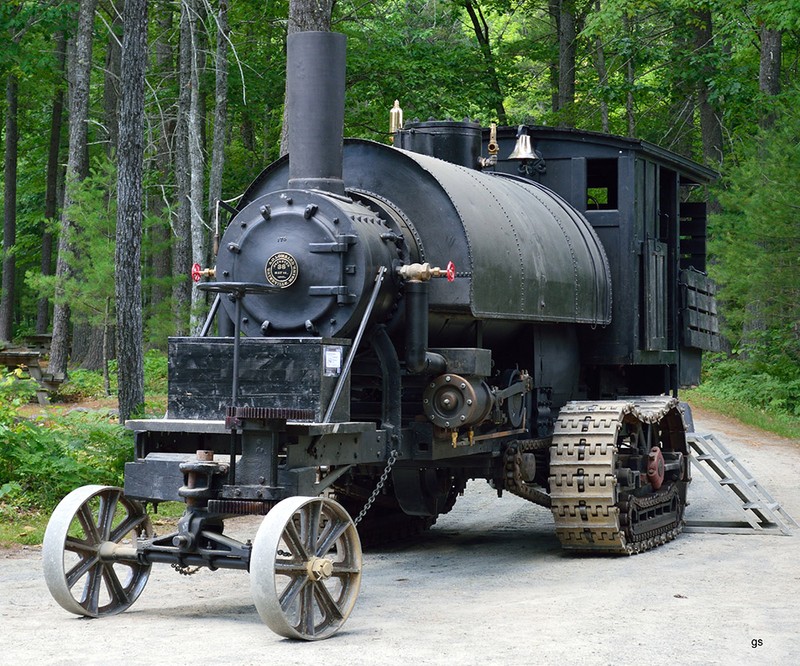Maine Forest and Logging Museum
Introduction
Text-to-speech Audio
The Maine Forest and Logging Museum preserves the history of Maine's logging industry and promotes sustainable forest agriculture. It is located on a former site of an actual sawmill that was owned by Oliver Leonard (1764-1828), a lawyer and speculator in lumber. The museum recreates a 1790s logging and milling community, featuring a reconstructed working "up and down" sawmill, a Blacksmith's shop, a bateaux (a small flat bottomed boat), a trapper's line camp, a covered bridge, and a settler's log cabin. Numerous tools and other artifacts are on display, and the visitors can read stories about the people who lived and worked in the industry. Highlights at the museum include the sawmill, a working Lombard log steam hauler, and a 1920s mill yard.
Images
The Maine Forest and Logging Museum

The Lombard Log Hauler which replaced the need for 50 horses

Backstory and Context
Text-to-speech Audio
Leonard's Mills, now called The Maine Forest and Logging Museum, was created in the 1950s. A group of volunteers came together to preserve the history of the logging and lumbering history of Maine since that is the biggest industry of the state. They proposed an outdoor museum that would be the first in the state to portray this history. Over the next decade, artifacts, documents, and tools of the industry were gathered to teach the visitors. It wasn't until the artifacts were all collected that the group realized they had too many interesting stories that had been collected over the years to let them go to waste.
Instead of an outdoor museum, a living history site was proposed. This way, the lives of the lumberjacks and loggers could be shown in an authentic way. Archaeologists had found evidence of sawmills on Blackman Stream in Bradley, Maine, so this location was picked as an authentic location. Scott Paper Co., Great Northern Paper Co., International Paper Co., St. Regis Paper Co., Diamond International Corp., Boise Cascade Paper Group, Dead River Co., Prentiss & Carlisle Co., J.W. Sewall Co., J.M. Huber Corp., Seven Islands Land Co., and J.D. Irving Ltd. donated a total of 204acres for the creation of the museum. The area was mostly forest, with the remnants of a stone dam on the stream. Soon, a water-powered sawmill was constructed, along with buildings that would have been lived in my loggers.
The entire living history site shows what life in the 1790s was like, with volunteers dressing in period clothes to make the experience authentic. The biggest attraction is the Lombard Log Hauler which was recently restored. This was the first tracked vehicle and successfully burned wood and traveled on iced roads. This machine replaced the need for fifty horses. The shingle museum is also operating, with volunteers showing how shingles were made from the trees that were harvested. A Blacksmith shop is also functional, showing visitors how different machines were made, along with other products such as horseshoes.
Instead of an outdoor museum, a living history site was proposed. This way, the lives of the lumberjacks and loggers could be shown in an authentic way. Archaeologists had found evidence of sawmills on Blackman Stream in Bradley, Maine, so this location was picked as an authentic location. Scott Paper Co., Great Northern Paper Co., International Paper Co., St. Regis Paper Co., Diamond International Corp., Boise Cascade Paper Group, Dead River Co., Prentiss & Carlisle Co., J.W. Sewall Co., J.M. Huber Corp., Seven Islands Land Co., and J.D. Irving Ltd. donated a total of 204acres for the creation of the museum. The area was mostly forest, with the remnants of a stone dam on the stream. Soon, a water-powered sawmill was constructed, along with buildings that would have been lived in my loggers.
The entire living history site shows what life in the 1790s was like, with volunteers dressing in period clothes to make the experience authentic. The biggest attraction is the Lombard Log Hauler which was recently restored. This was the first tracked vehicle and successfully burned wood and traveled on iced roads. This machine replaced the need for fifty horses. The shingle museum is also operating, with volunteers showing how shingles were made from the trees that were harvested. A Blacksmith shop is also functional, showing visitors how different machines were made, along with other products such as horseshoes.
Cite This Entry
M., Ben and Lauren Somers. "Maine Forest and Logging Museum." Clio: Your Guide to History. December 6, 2017. Accessed March 28, 2025. https://theclio.com/entry/19359
Sources
Maine Forest and Logging Museum. Accessed December 03, 2017. http://www.maineforestandloggingmuseum.org/.

